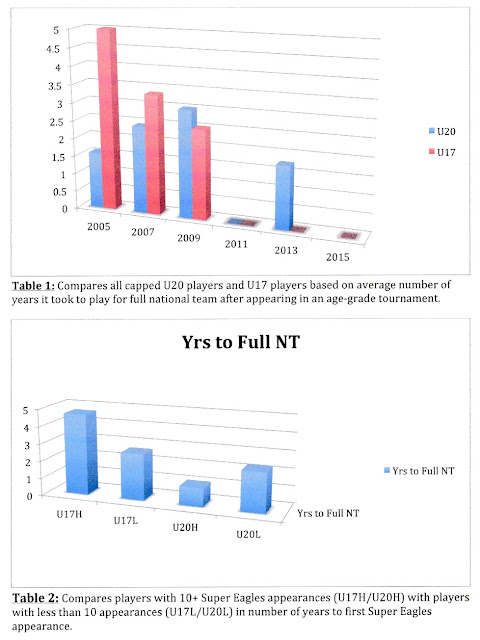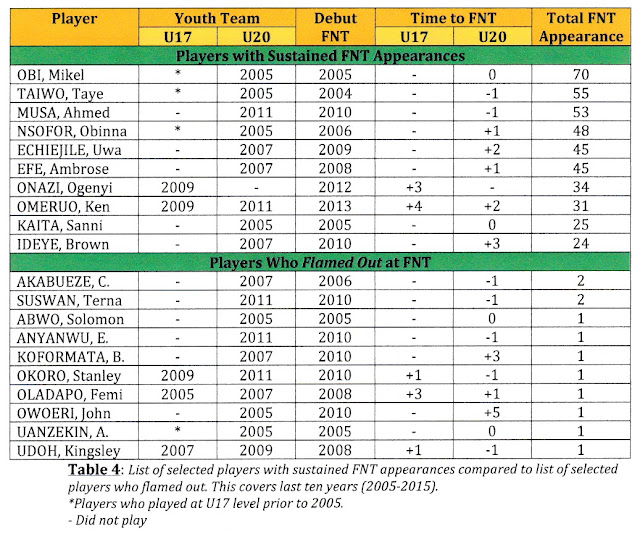Youth and Promotion to Super Eagles
Nigeria has dominated youth soccer in the world and in Africa, in particular, churning out talented youth footballers in a conveyor belt. However, many of these players have failed to continue the same level of productivity at the most senior level. This leads us to three paths of investigation: (1) How soon does Nigeria promote its youth players to the most senior national team (Super Eagles)? and (2) Is there a relationship between time it takes to introduce a youth player at the most senior level and their degree of productivity?
We have asked those two questions in response to the current media outcry to quickly promote recent U17 and U20 players to the full national team (FNT). We decided to look only at data from the last ten years. The last time Nigeria had massive promotion of youth players to the full national team, arguably, was in 2005 when several of them debuted in an international friendly against Benin Republic. In addition, Nigeria has also had a few players who appeared for the full national team before appearing for one of the national youth teams. These include Ahmed Musa, Uche Nwofor, and Chukwuma Akabueze.
Method: We only selected for this study youth players who appeared in either an African Youth Cup tournament or World Youth Cup tournament squad. Then we checked the date of their first game for the full national team. The time between their tournament appearance and their full national team appearance is the years to full national team(FNT) appearance e.g. Kenneth Omeruo appeared for the U17 in 2009 and U20 in 2011 and then debuted for full national team in 2013, thus, his time to FNT appearance is calculated as +4 from U17 and +2 from U20. To locate time it took U20 players of 2009 to reach the full national team (FNT) appearance is the sum of years it took all players from that squad to reach FNT divided by number of players who reached the FNT from that squad.
Results: Table 1 compares all players from youth squads since 2005. The table shows, expectedly, that it took U17 players longer, on average, to FNT. The exception is 2009 when it took U17 players less to get to FNT compared to U20 of same year. Note that 2009 was the year Nigeria hosted the U17 World Cup finals amid age cheating allegations. U20 squad of the same year had more players who went ahead to the FNT. However, their average to FNT is at 3 years and it is higher when compared to the U17 team which was at 2.5 years. The 2011 data shows an average of zero years to FNT for the U20 squad. In 2015, the only player to play for FNT is Kingsley Sokari who appeared for the FNT before playing for U20 and, thus, time to FNT is -1.0. For the U17 squads of 2011, 2013, and 2015 there is no player from those squads to play for the FNT as far as we know.
Table 2 compares U17/U20 (U17H/U20H)players who have appeared in 10 or more games for FNT to those who have appeared for less games for FNT. We find a confounding result. While those with high FNT appearances at U17 debuted later, on average, it was the opposite at the U20 level.
In Table 3, we cleaned the data in the hopes of removing confounding data found in Table 2. Here we removed all players who recently debuted and, thus, may appear for the FNT in 10 or more games at a later time. In addition, we compared those with 10 or more games for FNT to only those who have played two or less games for the FNT (removed those who just appeared for FNT). Effectively, this compares players with sustainable performance to those who "flamed out" quick. The result is dramatic! We now see that players who appeared in less games for FNT, on average, debuted on average earlier than those who have player 10 or more games.
Table 4 lists several of the players in our data set. It does not include all the players in the set. What it does include are top 10 in the list of players who have a sustained FNT appearance and a top 10 of players who "flamed out."
Table 4 lists several of the players in our data set. It does not include all the players in the set. What it does include are top 10 in the list of players who have a sustained FNT appearance and a top 10 of players who "flamed out."
What Did We Learn? Table 1 results were anticipated except for the aberration in 2009 data. However, Table 3 points to the possibility that youth players who debut later for the FNT are more likely to sustain their presence in the FNT than those who are fast tracked into the FNT and the result is stark at the U17 level. In fact, our data show that no U17 player who was introduced to the FNT in less than three years after appearing at a U17 tournament has been able to appear in 10 or more games at the FNT level in the last 10 years. However, at the U20 level we find that 13 of 14 players who sustained their FNT presence had debuted at the FNT level in three or less years removed from a U20 tournament (average = 1.07 years). Importantly, even at the U20 level where we found the above, we also found that players who flamed out after two or less games at the FNT level were fast tracked to the FNT in 0.5 years after a U20 tournament.






Comments
Post a Comment